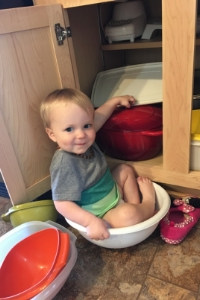You’ve probably heard a lot about positive parenting over the past few years. It seems everyone is recommending it as the best way to raise your kids. And you may wonder, what’s the best way to parent?
But what is positive parenting? How is it different from other parenting styles? Why is it more effective than more traditional parenting, such as the authoritarian parenting that many of us grew up with?
Let’s talk through where our parenting tactics usually come from, and why positive parenting is the best parenting style!
Table of Contents
Why do we parent like we do?
Think about the last time your child was really being troublesome. Perhaps it went something like this:
You got to daycare to pick up your child after a long day at work. She refuses to put on her shoes and says she doesn’t want to go home. When you finally get her home and settle in, you ask her to pick up toys out of the living room. Instead, she lies down on the floor like a limp noodle, refusing to do anything but whine.
What’s your immediate thought? Oh my gosh, this child is so lazy! And she doesn’t listen either. I’m raising a lazy, disrespectful child! What’s going to happen when she’s an adult?

How fear relates to parenting style
When we’re really upset by our child’s actions, it often comes from fear (whether you realize it or not). Deep down, we’re afraid that we can’t control the situation. Or, our mind runs into an imaginary future where we’re worried that we’re responsible for raising a “bad” person.
Even worse: Maybe we’re bad parents!
When I’m the most triggered by my kids, deep down, it’s really a fear about the future:
Oh my gosh, she’s never going to learn to share! She’s so selfish.
He’s always so disrespectful. He’s going to reflect badly on me!
I’m freakin’ going to be waking up three times a night with this kid for the rest of my life! (Come on, I know I’m not the only one here…)

When our minds start working operating under worst-case scenarios like these. we often come up with one solution: We have to crack down on this kid, now. We gotta get that child under control before the imaginary situation we’ve made up comes true!
You can see how parenting from fear (which, unfortunately, is often our default) leads to only reacting to our kids’ behaviors. But what’s better is to get ahead in our thinking, so we can respond to our kids’ needs.

Let’s discuss the parenting styles and how we can use that knowledge to use respectful, positive parenting.
Authoritarian vs permissive parenting – what’s wrong with both
Most of us heard that there were two ways of parenting when we were growing up. Perhaps the way you heard about parenting styles was overhearing your own parent(s) talking about how they thought other families were doing it wrong. Either way, the scale looked something like this:

Basically, there were two options.
Permissive parenting
If you had a permissive parent, everything was a free-for-all for you. You went out whenever you wanted, no one checked up on if you kept up with school work, and basically there wasn’t a lot of direction.
It may have seemed awesome at the time to go where you wanted, when you wanted, but looking back, you can see how this lack of oversight is not good for kids.
Authoritarian parenting
OR, you were raised by authoritarian parents. If you were raised this way, your parents were likely really hard on you, and you may have been browbeaten into submission (physically and/or emotionally) to make sure you didn’t step a toe out of line. This way, your parents were sure that you’d grow into a responsible adult.

Lots of us grew up under this style of parenting. We were always “good” kids, but there were a lot of emotions stuffed waaaay down, to never see the light of day.
RELATED: Positive parenting vs. spanking – the research
What’s wrong with the model of permissive parenting vs. authoritarian parenting
Intuitively, you know that there has to be more options than permissive or authoritarian parenting. They both have clear problems.
And even trying to do something “halfway between” the two extremes will probably just come out as wishy-washy parenting, where your parents are “nice” until you step too far, and then they crack down on you.
The main problem with this model is that parenting isn’t a sliding scale from permissive to authoritarian. Instead, it is better represented as a graph, like below.

In reality, there are two scales that interact with each other: How much empathy or sensitivity you show your child, and how high your expectations are. Let’s look at each section of this graph and discuss what each entails.
Low empathy, low expectations parenting
The bottom left of the graph contains parents who are low on empathy and low on expectations. An extreme version of this “parenting style” would be neglect.
You’re interested enough in parenting to read a blog about it, so my assumption is that you aren’t a neglectful parent by any means!
But you may have grown up in this kind of home, either due to some difficult situations your parents were going through, addiction, or some other painful problem that kept their attention away from you. If so, I’m sure it was hard, and I’m sorry for that.
But, I’m so glad that you are here, working to break generational patterns in your family! It’s a lot of hard work, but your children will be better for the effort you’re making in raising them. You, my friend, are awesome.
What’s wrong with permissive parenting?
Next, we can think about those who show empathy to their kids, but don’t communicate high expectations. This is what happens in permissive parenting.
If this is you, it doesn’t automatically mean you don’t care what happens to your child. Instead, it might indicate the opposite! You may love your kids so much that you don’t want to ever hurt their feelings!
Perhaps you don’t know how to convey expectations or motivate their child to achieve them. If this is you, perhaps you were parented in a harsh way and don’t want to carry that over to your own kid, so you have a hard time saying no.
Or heck, maybe you’re just too exhausted to deal with every time your kid disobeys. After all, you’ve got a lot going on in your life!
Regardless, if you’re in this group and you know that the lack of discipline is harming your child, there’s hope for things to get better! With a little work, you can learn some new thinking patterns and shift to a healthier parenting style.
RELATED: How mindfulness can make you a better parent
What’s wrong with authoritarian parenting?
The top left corner of the graph is the other extreme we may have experienced as kids: authoritarian parenting. This sort of parenting allows for few mistakes from children and includes more harsh punishments, whether physical (like spanking) or emotional (berating and withdrawal of love).
Unfortunately, many people praise this as the ideal parenting style. “You can’t be their friend; your job is to be their parent!” they’ll say.

Remember a while back, the article making its rounds across the internet bragging that science says that nagging mothers cause their daughters to be more successful?
I’ll be honest, when I read this article, it drove me bonkers with the inaccuracy. For one thing, the “scientific article” is not in a journal accepted by the scientific community. And the researchers doesn’t really measure success; all the article actually says is that daughters with higher parental expectations are less likely to get pregnant in high school.
So according to the article, success = not getting pregnant in high school. So many things wrong with this article (sidebar: one of the best people I know got pregnant in high school, and she is doing amazing things right now to help single moms going to college).
But the nagging article has a small grain of truth: many adult children of authoritarian parents are “successful.” They often have a traditional family structure of their own, respected jobs, and so forth. They look really good from the outside.
The problem? These adult children are also more likely to be anxiety prone. And this isn’t just for hard-core, abusive parenting. This is true even for garden-variety authoritarian parents.
So yeah, maybe your child will grow into an adult that does all the right things and looks good on the outside. But what is more valuable: “success” or inner peace and happiness with your decisions?
Why authoritative parenting is best for kids
The final section of the graph above, the upper-right quadrant, is the sweet spot. This is what we call authoritative parenting, where you display high empathy and sensitivity for your kids, but also have high expectations of them.

Another name for this style? Positive parenting, or responsive parenting.
If you grew up in areas where authoritarian parenting is the norm, you might initially be tempted to blow off the idea of authoritative parenting. “How else do you get kids to obey if you don’t show them that there’s consequences for their actions?”
But it can be done! With respectful parenting, kids will listen because they love and respect you, because you show them respect too.
Of course, this doesn’t mean that as long as you are nice to your kids they’ll never step out of line.
I’ll be honest: It takes more work to do respectful, positive parenting than authoritarian parenting, at least at the beginning.
Especially if you weren’t raised with respect, it takes a lot more mental energy to stop the rising panic leading us to react in a punitive fashion.
RELATED: How mindfulness can make you a better parent
RELATED: Teaching mindfulness to toddlers
Once you have calmed your own stress about a situation you are able to address it in a peaceful, problem-solving manner.
How to do positive parenting
It might take longer to get kids to do what you want with responsive, authoritative parenting, but you’re building their internal locus of control (the sense that they can control themselves instead of just being pushed around like a victim).
You may have fewer rules, but you’re teaching your kids to make choices built on character, not built on fear. As your children grow into teens and adults, this sense of self-control will be absolutely essential.
RELATED: The only three family rules you need
I hope this post has let you know that there’s another, more positive way to raise your kids than just focusing on shutting down “bad” behavior. Often, just taking a step back and asking a question (like in my article about taking turns) is enough.
RELATED: Teach your kids to take turns
Sometimes, this style of parenting takes more effort. But just like any other skill, the more you practice, the better you’ll get at it.
A huge factor in getting better at authoritative parenting? Using mindfulness in your daily life. For more details on how to use mindfulness (plus an interview with a PhD clinical therapist on the benefits of mindfulness on parenting!), check out this post.
RELATED: How mindfulness can make you a better parent
Get support for your peaceful parenting journey
If you’re ready to start peaceful parenting, you’ll need support. You can’t do respectful parenting alone, especially if you haven’t witnessed it before!
Sign up for the Mindful Mamas and Connected Kids toolkit. You’ll get eight pages of strategies you can implement immediately, including printable Mama Mantras (to place around the house!), the six step Tantrum Tamer process, and Playful Prompts for Cooperative Kids. Join here to get your toolkit today.

Thank you for the insight! It really helps to learn that there’s a way to parent besides either being permissive or authoritarian.
I got a lot of useful tips about how to parent from this article. It never occurred to me to think about parenting in a way besides strict or lax. Thank you!
You’re so welcome! Glad it helps.